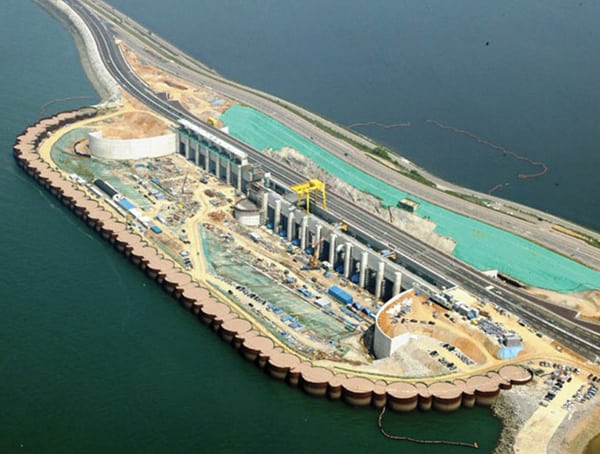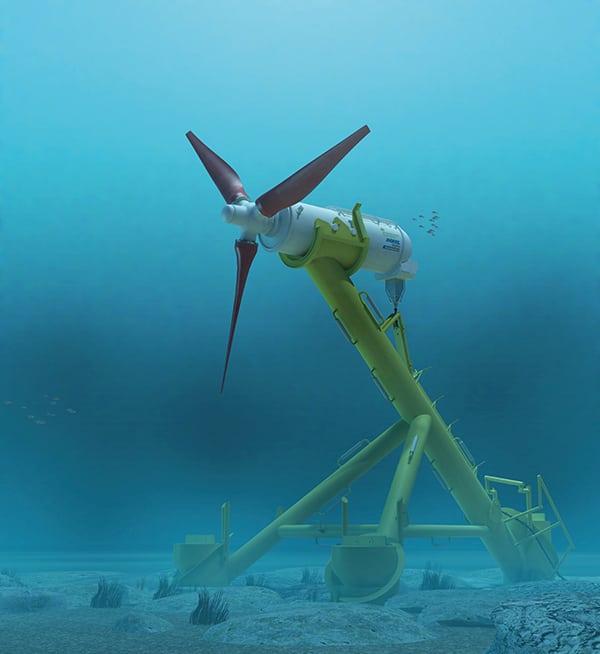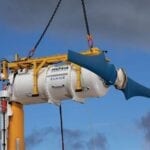The world’s ocean energy sector, which has over the past few years seen its share of developmental ebbs and flows, suffered a major storm this November after Siemens Energy said it would sell its tidal power arm and Pelamis Wave Power separately failed to raise needed funds to continue development.
Siemens in February 2012, with much fanfare, fully acquired Marine Current Turbines (MCT)—the UK-based company that had in 2008 installed the world’s first commercial-scale tidal current turbine, the 1.2-MW SeaGen, in Strangford Loch, a shallow inlet in Northern Ireland. In November, however, the company said the marine energy market and the supply chain had taken longer to grow than it expected, and that it was looking for a buyer for MCT. While a tidal power industry of “critical size” may develop in the future, due to the “limited resources” it would be too much of a niche market for Siemens, the company said in the statement.
Just days before, Pelamis, the 16-year-old UK-based manufacturer of the three semi-submerged snake-like wave energy devices that made up the world’s first commercial wave farm off the Aguçadoura coast in Portugal (commissioned in September 2008), announced it had gone into administration following a failure to secure funding for the next stage of development of its flagship device. German power company E.ON pulled out of a research project to test one of the company’s wave converters in mid-2013. The Scottish government in December said it would take on Pelamis’s assets, because no private bidders had come forward to buy the firm.
The two companies are just the latest in a string of capsized ventures. In 2013, German firm Voith Hydro decided to shutter its Wavegen operations in Scotland, and Irish wave energy converter maker Wavebob shut down after Spain’s Abengoa withdrew from a project and it failed to raise money and find another strategic partner. Earlier in 2014, high-profile Australian wave energy developer Oceanlinx went into liquidation after an A$7 million generator for its latest 3,000-metric ton prototype sank in a marine accident in March. New Jersey–based Ocean Power Technologies, which makes PowerBuoys to produce power from the motion of waves, canceled a project off the coast of Australia in July 2014, despite receiving a grant from the Australian government. In December, meanwhile, in an effort to keep afloat, ABB-backed wave energy company Aquamarine announced plans to lay off a “significant” number of staff as part of a restructuring of its business.
In an August 2014–released technology outlook, the International Renewable Energy Agency (IRENA) said the global installed capacity of ocean energy technologies was just over 530 MW at the end of 2013, with most of this capacity attributable to the 1966-commissioned 240-MW La Rance tidal barrage in France, and South Korea’s 2011-opened 254-MW Sihwa Lake tidal power station (Figure 1).
Compared to other ocean energy technologies, wave and tidal stream energy show the highest global interest, IRENA noted, which means they likely have the highest potential for significant commercial applications in the near- to medium-term.
But the wave sector, particularly, is in the grip of ongoing market consolidation, IRENA points out. Meanwhile, though more than 40 new tidal current or tidal stream technology devices were introduced between 2006 and 2013, most are still in the demonstration stage. The sector is seeing heightened engagement by large manufacturers, however. “Up to 2010, the [tidal current] industry was dominated by small entrepreneurial companies, but in the last three years large engineering firms and turbine manufacturers… entered the market,” said IRENA.
Over the past few years, Siemens bought MCT, Alstom also acquired Tidal Generation Ltd., ABB invested in Scotrenewables Tidal Power, and French naval defense company DCNS took over OpenHydro with projects deployed in Canada, France, and the UK. Prototype projects are also being backed separately by Hyundai Heavy Industries, Kawasaki Heavy Industries, and GDF Suez.
Not all ventures are seeing rough seas. Austrian firm Andritz Hydro, which in 2012 took over Hammerfest Strøm, in November 2014 announced it had received its first commercial order—from MeyGen Ltd. for three 1.5-MW tidal current turbines (Figure 2) to be installed in a planned tidal array in the Inner Sound of the Pentland Firth in Scotland.
IRENA noted that progress into full-scale production of the variety of ocean energy technologies has been complicated by a number of obstacles. Among them are accessing finance, administrative barriers, ecological impacts, and lack of grid connections. They also typically lag in technical maturity, owing to challenges of working in an offshore environment. Levelized costs of ocean energy technologies are currently substantially higher than those of other renewable energy technologies, it notes, and the “long-term pathway to cost reduction is difficult to predict,” because of limited empirical cost data and the wide variability in project costs.
Yet, while deployment rates of ocean energy technologies have been “slower than expected,” technology and market trends indicate that they could possibly become cost competitive with other renewables from the 2020s onward, the organization predicts.
—Sonal Patel, associate editor












